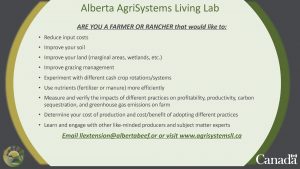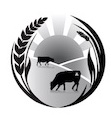The Alberta AgriSystems Living Laboratory (AALL) represents a new approach to combating global climate change, and is a component of the broader federal Agricultural Climate Solutions (ACS) program. The ACS program is designed to combine traditional agricultural research with on-farm/ranch producer knowledge in a co-development process that evaluates newly-implemented beneficial management practices (BMPs).
Individual BMPs are evaluated on how they can improve productivity and profitability, reduce greenhouse gas (GHG) footprints and increase carbon storage in agricultural lands. ACS projects are led by non-research organizations (e.g., industry and not-for-profits) who serve as liaisons to facilitate on-farm/ranch co-development and evaluation of BMPs. The AALL is one such organization, led by the Alberta Beef Producers. It draws on the expertise of a wide range of industry partners from across the province, including crop commissions, non-governmental organizations, and private industry.
The network of living labs nationwide has the goals of increasing our fundamental understanding of agricultural impacts on soil carbon stock, stability, and GHG dynamics, and of fostering a greater understanding among producers as to how they may help combat climate change while benefiting their bottom line. The combination of fundamental research and on-farm/ranch co-development in which agricultural experts advise on implementing BMPs as well as monitoring field-level responses allows for an enhanced predictive framework on how widespread changes in agricultural land-use practices can benefit all of society.
Several BMPs are capable of contributing to carbon storage and GHG mitigation. These include practices such as intercropping, restoration of perennial forage lands, strategic enhancement of plant diversity (e.g., in forage lands), agroforestry, riparian area conservation, and the use of technologies to increase fertilizer use efficiency and reduce nutrient loss. Additionally, with nearly 10 million hectares of grazing land in Alberta supporting more than 1.5 million breeding cows, finding ways to increase carbon storage in perennial grazing lands is an important strategy to combat climate change. Grazing lands are important for storing soil carbon, typically supporting 30-50% larger carbon stocks than annual cropland. Moreover, grazing lands provide other environmental goods and services (EG&S), such as conserving biodiversity, supporting wildlife, reducing erosion, and maintaining water quality. While the benefits of perennial forage lands over croplands are relatively well-known, what is less understand is HOWgrazing can be fine-tuned to increase these EG&S, including enhancing carbon storage and GHG reduction.
Recent work completed at UAlberta using a network of study ranches across Alberta, Saskatchewan and Manitoba suggests that a specialized form of rotational grazing, known as adaptive, multi-paddock (AMP) grazing, could benefit grasslands and producers. AMP grazing entails the use of small paddocks and elevated stock densities, with frequent moves to ensure long recovery periods between grazing events. On those sites, long-term use of AMP grazing improved water infiltration and forage production. In addition, AMP-grazed grasslands had deeper topsoils that contained more carbon, and the microbial community of AMP soils had greater methanotrophic activity, which increased ‘consumption’ of methane. Based on these very encouraging results, this work is being expanded within the AALL to more comprehensively field-test the benefits of AMP grazing on a variety of EG&S, including pasture health, forage agronomics (yield and quality), carbon storage and GHG dynamics.
Among the novel aspects of the AALL program is the projects’ interdisciplinary nature. Researchers work hand-in-hand with producers to identify opportunities to implement BMPs, foster their implementation, and then monitor their impact. Together with the collection of field data evaluating changes in carbon stock and stability, and ongoing fluxes of GHGs such as CO2, CH4 and N2O, is the assessment of net impacts of BMPs on producer cost of production and, therefore, profitability. Additionally, detailed management data on the land use activities prior to the study and during the interval encompassed by the monitoring period from 2023 through 2026, during and following BMP implementation, are used to better understand when, where and how land use practices may mitigate climate change, while fully assessing their feasibility of implementation. Furthermore, the AALL includes a socio-economic evaluation of the uptake of BMPs by participants directly involved in the AALL and producers throughout Alberta. Producers interested in adopting BMPs themselves will have the opportunity to view and learn about the impacts of newly-implemented BMPs in similar production scenarios. The grazing management component of the AALL is being led by Edward Bork (of the Rangeland Research Institute and Gentec partner) with a large team of scientists from UAlberta with expertise in many disciplines. Gentec scientists including Carolyn Fitzsimmons and ChangXi Li of Agriculture and AgriFood Canada and John Basarab and Paul Stothard (UofA) will be considering how genomics can support these efforts.
If you are a rancher and interested in participating in the project, contact Edward Bork for more information.
If you are an agricultural producer (cropping, beef, forage) and interested in the AALL and other BMPs, check out the website.



